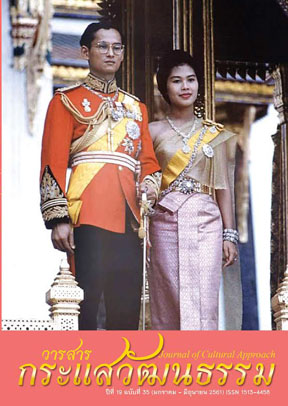Thai Popular Songs for Children from 1939 to 1957
Main Article Content
Abstract
Thai popular songs for children (1939 – 1957) can be divided in two sections. First, songs that have political influence and second, songs without any political influence, but they were used for children. During the period from 1939-1957, it was the period ruled by the prime minister, Field Marshal Plaek Phibunsongkhram. He ordered great changes concerning Thai culture and lifestyle of Thai people. Music was one of the key factor of changes. Many musical bands were under the control of Thai government, they were ordered to establish and compose new songs and play in public. Many songs from those bands appeared to be songs for children. In this period, there were many songs that showed specific need in improving the knowledge and understanding of the new politics, but also more songs were composed for improvement of ethics and public discipline of the young people. Those songs were played to teach young children in schools to teach and practice in the singing classes.
Analysis studies showed various styles of children songs. All of them used western music form and melodies. New lyrics were composed along with the government ideas, but many were selected from old literature and plays as well as from the religious teaching document. Wordings were written in very fine Thai language with easy understanding. There were many form of music such as the binary, ternary, rondo and the 32 bars forms. Moreover, those children music and songs were also signified the historical evidences of the political dominances of which the government at the time had tried so hard to make the kingdom up to date and to be away from western colonization. Besides, the results also showed that Thailand had used western pop music as tools for modern national development of which those time western music studies in the country were not very popular like today. This might be a good reason to understand the progressive and well establishment of music schools in Thailand after the Second World War as well.
Article Details
Proposed Creative Commons Copyright Notices
1. Proposed Policy for Journals That Offer Open Access
Authors who publish with this journal agree to the following terms:
- Authors retain copyright and grant the journal right of first publication with the work simultaneously licensed under a Creative Commons Attribution License that allows others to share the work with an acknowledgement of the work's authorship and initial publication in this journal.
- Authors are able to enter into separate, additional contractual arrangements for the non-exclusive distribution of the journal's published version of the work (e.g., post it to an institutional repository or publish it in a book), with an acknowledgement of its initial publication in this journal.
- Authors are permitted and encouraged to post their work online (e.g., in institutional repositories or on their website) prior to and during the submission process, as it can lead to productive exchanges, as well as earlier and greater citation of published work (See The Effect of Open Access).
Proposed Policy for Journals That Offer Delayed Open Access
Authors who publish with this journal agree to the following terms:
- Authors retain copyright and grant the journal right of first publication, with the work [SPECIFY PERIOD OF TIME] after publication simultaneously licensed under a Creative Commons Attribution License that allows others to share the work with an acknowledgement of the work's authorship and initial publication in this journal.
- Authors are able to enter into separate, additional contractual arrangements for the non-exclusive distribution of the journal's published version of the work (e.g., post it to an institutional repository or publish it in a book), with an acknowledgement of its initial publication in this journal.
- Authors are permitted and encouraged to post their work online (e.g., in institutional repositories or on their website) prior to and during the submission process, as it can lead to productive exchanges, as well as earlier and greater citation of published work (See The Effect of Open Access).
References
[2] Amatayakul, Poonpit. (2007). Archives of Music in 5 Periods. Bangkok: Duan Tula Press.
[3] Amatayakul, Poonpit. (2011). The Birth of Thai Popular Songs: Idea of Musicology. Bangkok: Ammarin Publishing.
[4] Bellman, J. D. (2007). A Short Guide to Writing. United States: Person Longman.
[5] Bread, D. & Gloag, K. (2005). Musicology the Key Concepts. New York: Routledge Taylor & Francis Group.
[6] Kasetsiri, Charnvit., Petchlert-anant, Thamrongsak. & Pongpanitanon, Vikan. (2001). Field Marshal Plaek Phibunsongkhram with New Period of Politic. 2nd ed. Bangkok: The Foundation for the Promotion of Sciences and Humanities Textbooks Project.
[7] Kasetsiri, Charnvit. (2008). Political History of Thailand. 5th ed. Bangkok: The Foundation for the Promotion of Sciences and Humanities Textbooks Project.
[8] Mora. (1936). Shan Yaowapoj Vol. 4 Remembrance in Cremation of Mrs. Boriharnwanakhet (Chareon Chukiat). Bangkok: Aksorn Sopon Press. (in Thai)
[9] Myers, H. (1992). Ethnomusicology: Historical and Regional Studies. New York: W. W. Norton & Company.
[10] Narinkul, Prapasri. et al. (1981). Remembrance in Cremation of Mr.Kaew Autchariyakul (Kaewfa). Bangkok: Rungrueng-Tham press. (in Thai)
[11] Natchanawakul, Nachaya. (2012). Western Music in Siam: The Development between A.C.1841-1941. Thesis in Philosophy of Music, Graduate School, Mahidol University.
[12] Nawigamune, Anake. (2007). Pleang Nok Sattawat. 4th ed. Bangkok: Matichon Press. (in Thai)
[13] Payathai, Kita. (2015). Cha-aum Punchapan Composer who Creative Wonderful Love Songs. Bangkok: Sangdao Press.
[14] Poomsa-ard, Somchai. (1978). Mora Great Poet of Rattanakosin. Silpakorn Magazine, 1, 65-77.
[15] Royal Society. (2007). Doksoi Suparsit. Bangkok: Public Relations Group of Deputy Officer in Ministry of Culture. (in Thai)
[16] Sookhom, Naiyana. (1981). Study of Field Marshal Plaek Phibunsongkhram for Explain Changing of Culture in 1938 to 1944. Thematic Paper Bachelor of Music (Humanities), Silpakorn University.
[17] Tangtrong-jit, Kowit. (2011). Lao Kwam Lang Krang Song Khram. Bangkok: Pimkham Press. (in Thai)


